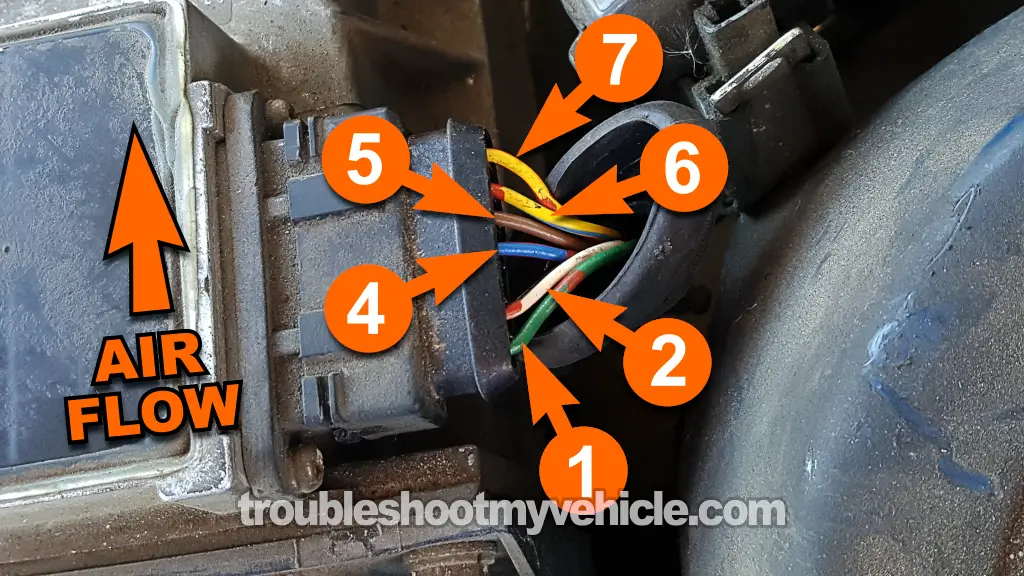
The MAF sensor on the 1987-1991 2.0L Toyota Camry is a vane air flow type sensor and it can be easily and quickly tested with a multimeter.
In this tutorial, I'll explain how to test it step-by-step. With your test results, you'll be able to determine if its good or bad.
NOTE: I'll be referring to the vane air flow sensor as the MAF sensor in this tutorial.
Contents of this tutorial:
APPLIES TO: This tutorial applies to the following vehicles:
- 2.0L Toyota Camry: 1987, 1988, 1989, 1990, 1991
Wiring Diagrams: You can find the MAF sensor circuit wiring diagram here:
- MAF Sensor And Fuel Pump Circuit Wiring Diagram (1987 2.2L Toyota Camry).
- MAF Sensor And Fuel Pump Circuit Wiring Diagram (1988-1989 2.2L Toyota Camry).
- MAF Sensor And Fuel Pump Circuit Wiring Diagram (1990-1991 2.2L Toyota Camry).
MAF Sensor Basics
The MAF sensor in the 1987-1991 2.0L Toyota Camry is a vane-type sensor, sometimes referred to as a flap-type air flow meter.
It plays a critical role in keeping the engine running smoothly and efficiently by measuring the amount of air entering the engine.
In a nutshell, this is how it works:
- Mechanical operation:
- Inside the sensor, there's a mechanical vane (or flap) connected to a spring-loaded arm. As the engine sucks in air, the air flow pushes the vane open. The amount the vane moves is proportional to the volume of air entering the engine.
- Signal generation:
- The vane's movement is linked to a variable resistor (potentiometer). As the vane moves, it changes the resistance in the circuit, generating an electrical signal.
- This signal is sent to the engine control unit (ECU), providing information about the air flow rate.
- The ECU uses this data to calculate the correct amount of fuel to inject, ensuring an optimal air-fuel mixture for combustion.
- The vane's movement is linked to a variable resistor (potentiometer). As the vane moves, it changes the resistance in the circuit, generating an electrical signal.
- Intake air temp sensor:
- The MAF sensor includes an integrated intake air temperature (IAT) sensor to adjust the air-fuel mixture based on temperature changes.
Common Symptoms Of A Bad MAF Sensor
The vane-type design is mechanical and for this reason, it can wear out over time due to constant movement of the vane or potentiometer and exposure to contaminants.
Another common issue, is a cracked housing or rubber air duct that'll cause leaks in the air intake system resulting in incorrect air flow readings.
When the MAF sensor fails, you'll see one or more of the following:
- A MAF sensor code.
- A tremendous lack of power upon acceleration.
- Hesitation or stumbling during acceleration.
- Rough idle.
- Engine stalls.
- Black smoke coming from the tail-pipe.
- Bad gas mileage.
Circuit Descriptions Of The MAF Sensor

| Pin | Wire Color | Description |
|---|---|---|
| 1 | Green (GRN) | Fuel Pump Cut-Off Circuit |
| 2 | White with black stripe (BLK/WHT) | Fuel Pump Cut-Off Circuit |
| 3 | Not Used | ---- |
| 4 | Blue with red stripe (BLU/RED) | 5 Volts Input (from ECM) |
| 5 | Brown (BRN) | Sensor Ground |
| 6 | Yellow with blue stripe (YEL/BLU) | MAF Signal (output) |
| 7 | Yellow with red stripe (YEL/RED) | Intake Air Temp Sensor |
You'll notice that in the photo above the MAF connector is numbered 1 thru 7. The only circuits that we're going to be concerned about (to test the MAF sensor) are circuits number 4, 5, and 6.
TEST 1: Making Sure The MAF Sensor Is Getting Power

The very first thing that we'll do is check that the MAF sensor is receiving 5 Volts DC.
These 5 Volts are supplied by your Camry's fuel injection computer thru the blue with red stripe (BLU/RED) wire of the MAF sensor connector.
In the photo above, I've labed the BLU/RED wire with the number 4.
These are the test steps:
- 1
Disconnect the MAF sensor from its electrical connector.
- 2
Place your multimeter in Volts DC mode.
- 3
Turn the key ON but don't crank or start the engine.
- 4
Connect the black multimeter probe to the battery negative (-) post.
- 5
Probe the female terminal that connects to the wire labeled with the number 4 with the red multimeter test lead
The female terminal should connect to the BLU/RED wire. - 6
The multimeter should read 4.5 to 5 Volts DC.
Let's interpret your test result:
CASE 1: Your multimeter registered 4.5 to 5 Volts DC. This is the correct and expected test result.
Your next step is to go to: TEST 2: Making Sure The MAF Sensor Is Getting Ground.
CASE 2: Your multimeter DID NOT register 4.5 to 5 Volts DC. This test result tells you that the MAF sensor is not getting power. Without power, it will not function.
Your next step is to find out why these 5 Volts are missing and restore them.

